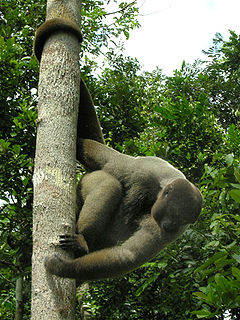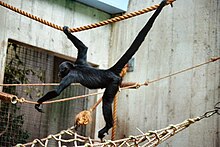
New World monkeys are the five families of primates that are found in the tropical regions of Mexico, Central and South America: Callitrichidae, Cebidae, Aotidae, Pitheciidae, and Atelidae. The five families are ranked together as the Ceboidea, the only extant superfamily in the parvorder Platyrrhini.

The woolly monkeys are the genus Lagothrix of New World monkeys, usually placed in the family Atelidae.

Howler monkeys are among the largest of the New World monkeys. They are famous for their loud howls, which can travel more than one mile through dense rain forest. These monkeys are native to South and Central American forests. Threats include human predation, habitat destruction, and capture for pets or zoo animals. Fifteen species are recognized. Previously classified in the family Cebidae, they are now placed in the family Atelidae.

The Atelidae are one of the five families of New World monkeys now recognised. It was formerly included in the family Cebidae. Atelids are generally larger monkeys; the family includes the howler, spider, woolly, and woolly spider monkeys. They are found throughout the forested regions of Central and South America, from Mexico to northern Argentina.

Spider monkeys are New World monkeys belonging to the genus Ateles, part of the subfamily Atelinae, family Atelidae. Like other atelines, they are found in tropical forests of Central and South America, from southern Mexico to Brazil. The genus consistes of seven species, all of which are under threat; the brown spider monkey is critically endangered. They are also notable for their ability to be easily bred in captivity.

The common woolly monkey, brown woolly monkey, or Humboldt's woolly monkey is a woolly monkey from Colombia, Ecuador, Peru, Bolivia, Brazil, and Venezuela. It lives in groups of two to 70 individuals, usually splitting the group into smaller subgroups when active.

The white-bellied spider monkey, also known as the white-fronted or long-haired spider monkey, is an endangered species of spider monkey, a type of New World monkey. It is found in the north-western Amazon in Colombia, Ecuador, Venezuela, Peru and Brazil, ranging as far south as the lower Ucayali River and as far east as the Branco River. In the past, the Peruvian, brown and white-cheeked spider monkeys have been treated as subspecies of A. belzebuth. As presently defined, the white-bellied spider monkey is monotypic. It has a whitish belly and a pale patch on the forehead, which, despite its common name, often is orange-buff, though this might be due to dirt and other stainers. They live in groups of 20 to 40 individuals, splitting into small parties of 1 to 9 when in activity.

The gray woolly monkey or Geoffroy's woolly monkey is a subspecies of the common woolly monkey from South America. It is found in Bolivia, Brazil and Peru. L. l. cana gets its common name, gray woolly monkey, from its thick gray coat. Its hands, feet, face and the inside of the arms are dark in color. The gray woolly monkey has been considered endangered by IUCN since 2008. The subspecies is listed as endangered because it suffered a 50% decrease in population over the past 45 years due to deforestation and hunting.

Geoffroy's spider monkey, also known as the black-handed spider monkey or the Central American spider monkey is a species of spider monkey, a type of New World monkey, from Central America, parts of Mexico and possibly a small portion of Colombia. There are at least five subspecies. Some primatologists classify the black-headed spider monkey, found in Panama, Colombia, and Ecuador as the same species as Geoffroy's spider monkey.

The Peruvian spider monkey, also known as the black-faced black spider monkey, is a species of spider monkey that lives in Peru, as well as in Brazil and in Bolivia. At 60 centimetres long, they are relatively large among species of monkey, and their strong, prehensile tails can be up to 1 m (3 ft) long. Unlike many species of monkey, they have only a vestigial thumb, an adaptation which enables them to travel using brachiation. Peruvian spider monkeys live in groups of 20–30 individuals, but these groups are rarely all together simultaneously. The size and dynamics of the resulting subgroups vary with food availability and sociobehavioral activity. They prefer to eat fleshy fruit, but will change their diet in response to scarcity of ripe fruit. Individuals of this species also eat small animals, insects and leaves based on availability. Females separate from the band to give birth, typically in the fall. These females inhabit a group of core areas where resources are abundant in certain seasons. Typically, males exhibit ranging over longer distances than females, with movement of individuals enhancing the fluidity of subgroup size. Peruvian spider monkey are independent at about 10 months, with a lifespan of about 20 years.

The Bolivian red howler is a species of howler monkey, a type of New World monkey, endemic to Bolivia. It can be found in rain forests, including riverine and seasonally flooded forests.

The mantled howler is a species of howler monkey, a type of New World monkey, from Central and South America. It is one of the monkey species most often seen and heard in the wild in Central America. It takes its "mantled" name from the long guard hairs on its sides.

The Yucatán black howler, or Guatemalan black howler, is a species of howler monkey, a type of New World monkey, from Central America. It is found in Belize, Guatemala and Mexico, in and near the Yucatán Peninsula. It lives in evergreen, semideciduous and lowland rain forests. It is also known as the baboon in Belize, although it is not closely related to the baboons in Africa.
Solimoea acrensis is a prehistoric ateline monkey from the Late Miocene Solimões Formation of Brazil. It is the only known species of the genus Solimoea.

The Azuero spider monkey is a possible subspecies of spider monkey that is in critical danger of extinction according to the IUCN Red List of Threatened Species. Common names of this subspecies include mono charro, mono charao and mono araña. The Azuero subspecies is one of three types of spider monkeys in Panama; Ateles geoffroyi panamensis with a range spanning from Costa Rica to Darién excluding the Azuero, Ateles geoffroyi fusciceps, with a range spanning Panamá and Colón provinces, and Ateles geoffroyi azuerensis, the Azuero spider monkey, whose range encompasses only the Azuero Peninsula.
Protopithecus is an extinct genus of large New World monkey that lived during the Pleistocene. Fossils have been found in the Toca da Boa Vista cave of Brazil, as well as other locales in the country. Fossils of another large, but less robust ateline monkey, Caipora, were also discovered in Toca da Boa Vista.














